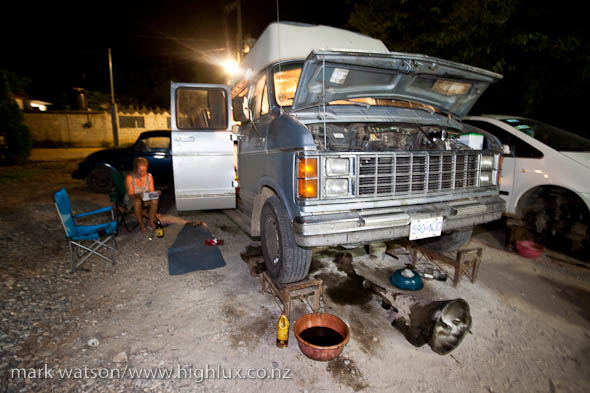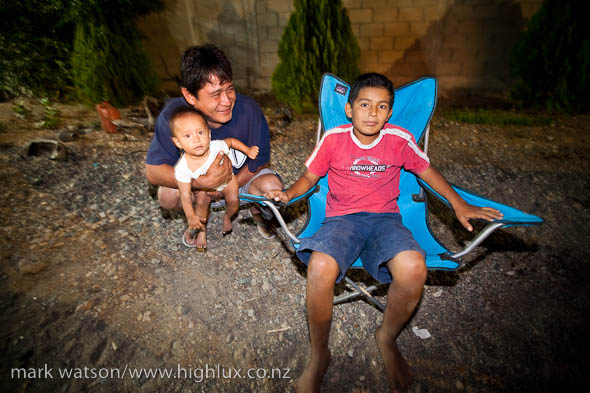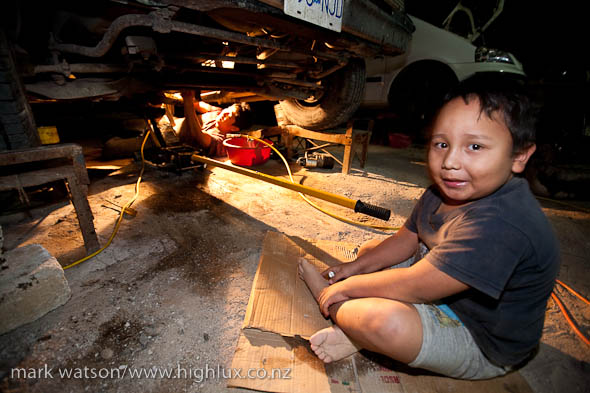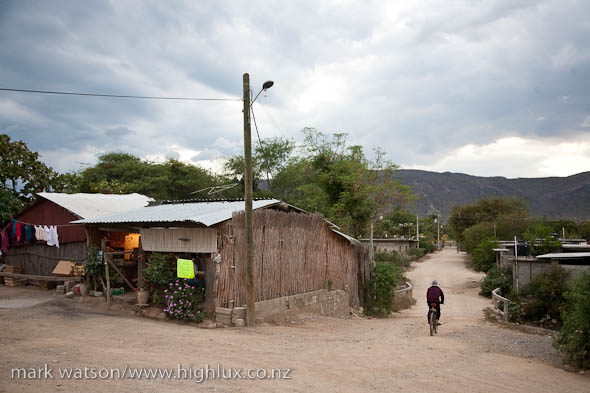How to get your transmission fixed in one of the poorest states in Mexico …
When you buy a 1981 Dodge, and drive from Vancouver to the southern-most point of Mexico over 7 months certain repairs can be expected – it comes with the territory. You could say we haven’t had the best run with our vehicle, but repairs so far have been more a brief inconvenience rather than especially expensive.
We did run into some frustrating electrical issues early on which saw us go through two alternators and batteries. The starter motor died on us too, and then the replacement one turned out to be faulty after only a day or two back on the road. Two new tie rods were the biggest ouch so far at US$600 plus labour – but that’s possibly just the start of our ‘front end’ issues.
Since arriving in Mexico we developed a crack in our exhaust, but this was fixed at a ‘mofles’ repair joint with a new section of exhaust welded in for a total cost of NZ$25! The hilly, windy roads have taken their toll on our brakes too and they started to fail as we drove out of Puerto Vallarta one day. We pulled into a brake repair place and a team of teenage boys spent the next two hours fully servicing both disk and drum brakes with new pads, fluid etc for about NZ$180. Mexican mechanics are incredibly resourceful, and the philosophy here is very much one of repair-rather-than-replace.
Mechanics here charge about a tenth of what US mechanics do for labour too, a fact that probably saved our trip and our van when our transmission started to fail shortly after heading inland towards Chiapas state. After spending the better part of a morning driving fruitlessly around small towns in 30 degree heat looking for a transmission specialist we eventually pulled into a very run down and basic car repair place on the side of the highway, not far out of Tehuantepec. The word ‘transmissions’ painted jauntily on the side of the workshop pulled us in there, but by the look of the equipment they had and the half-repaired cars scattered around the yard we thought they’d be barely set up to change a tyre. The mechanic there got on his mobile phone to call a transmissions guy and half an hour later David rolled in with his four-year-old son in tow.
We drove down the highway with David on board and sure enough the transmission starts slipping like crazy – in and out of gears – the engine revving like mad. Somehow managing with our very limited Spanish and David’s few words of English, we figured our that David knew what the problem was: most likely worn belts, plates, bushings and seals – necessitating a complete overhaul of the transmission; taking it out, taking it apart, replacing worn parts and then putting the whole thing back in again. A job like this costs at least US$2000 from what we’d read. David’s quote for labour and parts: 7000 pesos, or about NZ$750. ‘Ok – do it’, we say. As we drove back to the roadside garage/chicken shed David said he reckoned it would take about three days – for the labour-intensive job, as parts had to arrive from a bigger town.
‘Three days!’ we think. We’re pondering where to stay and what to do for three days while we leave our camper in the hands of mechanic we know nothing about, when David says in his limited and broken English that he will work on the camper at his house and that we will come and stay with his family while he does the work.
Standing on the side of the dusty highway in the searing heat and with virtually no alternative we accepted David’s generous offer, but a whirlwind of doubt swirled around in our heads: what if the transmission is not that bad? What if this guy is useless? What’s his workshop like? Should we try to go to a bigger town?
We returned to the garage and then followed David’s ute as it bounced through potholded back roads into the tiny village of San Luis Rey – the kind of place where goats and chickens graze the streets and kids stare at you like they’ve never seen a white person before (and some of them hadn’t).
 We arrived at David’s house, and soon saw that his ‘workshop’ was nothing more his front yard, and that he had the basics and not much more: some wheel ramps, a car jack, a compressor, a tiny wooden table and a few hand tools.
We arrived at David’s house, and soon saw that his ‘workshop’ was nothing more his front yard, and that he had the basics and not much more: some wheel ramps, a car jack, a compressor, a tiny wooden table and a few hand tools.
I’m not one for religious affirmation in times of duress but ‘Inshallah’ ran through my mind. We both knew we just had to go with it.
With the camper up on the wheel ramps, David introduced us to his family: his wife Guadalupe and his three kids.
‘This is your house,’ David says in broken English, gesturing to the three roomed, unlined and unpainted concrete shell that his family lives in. It’s basic: there’s no running hot water, and the house is half finished – but it’s their home. They’re clearly poor, but willing to share everything they have with us while the camper gets fixed. For the next three days we eat most meals with the family and become a part of their daily routine.
‘Today – take out transmission, tomorrow fix, next day replace – then you go,’ he says.
We’ve got to find a way around the language barrier, because we barely understand each other, so David recruits an 11 year old boy who lives down the road. The boy grew up in Phoenix, AZ and speaks almost perfect English. Saved!
Working into the night David drained the transmission and found various pieces of debris on the filter – a sure sign of damage. Next he extracted it from the camper – with Guadalupe fine tuning a car jack under the tranny while he unbolted it and manouevered it past the exhaust without tearing it off.
 The following day Hana and I became a hit with the local kids, while David dismantled the tranny and pulled out disintegrated bushings and other well-worn parts. He picked up the replacement parts later that day and by dark the unit was rebuilt and ready to go back into the camper. With lights rigged up David reinstalls it that night (with Guadalupe on the jack again), and by 10 pm that night we’re refilling the camper with transmission fluid and getting ready for a road test. For such a basic set-up David’s efficiency and handling of the whole process is incredible. He later tells me he’s repaired and rebuilt 28 transmissions in the last 18 months using this set up. He learned his trade working in the US several years ago in what must have been a total contrast to his home ‘workshop’ set up.
The following day Hana and I became a hit with the local kids, while David dismantled the tranny and pulled out disintegrated bushings and other well-worn parts. He picked up the replacement parts later that day and by dark the unit was rebuilt and ready to go back into the camper. With lights rigged up David reinstalls it that night (with Guadalupe on the jack again), and by 10 pm that night we’re refilling the camper with transmission fluid and getting ready for a road test. For such a basic set-up David’s efficiency and handling of the whole process is incredible. He later tells me he’s repaired and rebuilt 28 transmissions in the last 18 months using this set up. He learned his trade working in the US several years ago in what must have been a total contrast to his home ‘workshop’ set up.
At 11 pm we’re out on the highway road testing and David’s work seems to be working flawlessly.
‘It’s good, the box is good,’ he repeats over and over.
‘Muy bien.’ We reply – stoked to be able to get back on the road the following morning.
Come morning we head out for another road test and after half an hour return to David’s for the last time, satisfied that the tranny is back in order and with the confidence to hit the road. We make our farewells, and I shoot a polaroid of the family for them to keep. They love it, and it’s not something they get from their usual customers!
 A couple of hours later we’re climbing a winding road into the highlands, windows wound down in the heat and feeling stoked to be on the road again when the transmission starts to slip … and slip and slip. We can’t believe it.
A couple of hours later we’re climbing a winding road into the highlands, windows wound down in the heat and feeling stoked to be on the road again when the transmission starts to slip … and slip and slip. We can’t believe it.
‘What the f**k is going on?’
We pull over after a kilometre and I check the transmission fluid for signs of trouble. It’s smoking slightly, or is it condensing… I’m not sure – but it’s possibly not a good sign. It doesn’t smell burnt and hasn’t changed colour so we’re left scratching our heads. It’s two hours back to David’s house – and there’s scarcely a mechanic between. A nearby house lets us use their phone and a very surprised David answers our call.
‘Come back, I check it,’ he says.
So we hop in the camper, and with the transmission apparently cooled enough to be functional we turn around and head back, with the tranny slipping occasionally. It’s about 5 pm by the time we get there – another day wasted and we’re feeling hot, pissed off and tired of driving the same roads over and over.
David insists that we go back out for a road test there and then. He wants to see the problem for himself, and recruiting our 11-year old interpreter again we explain that’s it’s a very intermittent problem and that the fluid had been smoking when I checked it. We drive for about an hour along the highway with not the slightest problem. At one point David tells us to stop, hops out and adjusts the throttle control on the outside of the tranny (to adjust when the shifts happen). But this just leads to more confusion. We wonder if he even understands how bad the slipping is when it happens.
The following morning we’re on the road with David again – praying for the damn thing to slip so he can see what the problem is. But it never does.
‘The box is good,’ he says again. ‘Shifting good, no problem.’
We’re surprised that he doesn’t bother to check anything else in the system – he doesn’t give the transmission the once over to see if anything can be causing the problem. He’s so confident in his work.
 With no alternative and David’s insistence that we’re good to go with nothing more that a slight adjustment to the throttle control were back off down the highway by mid morning. A couple of hours later we’re in the hills again – taking it easy, keeping the coolant temp down, and there it goes – slipping again. Checking the fluid I see a small amount of smoke again, but this time the transmission fluid smells funny too. Taking it easy we drive the final few kilometres into the city of Tuxtla Guttierrez and find a place to stay for the night. I spend hours on the internet that evening reading about the causes of transmission slippage, overheating and other problems – desperate to find a clue about the cause of our problem. The obvious conclusion is that there’s a problem with the transmission cooling system – but David would have checked that, surely!
With no alternative and David’s insistence that we’re good to go with nothing more that a slight adjustment to the throttle control were back off down the highway by mid morning. A couple of hours later we’re in the hills again – taking it easy, keeping the coolant temp down, and there it goes – slipping again. Checking the fluid I see a small amount of smoke again, but this time the transmission fluid smells funny too. Taking it easy we drive the final few kilometres into the city of Tuxtla Guttierrez and find a place to stay for the night. I spend hours on the internet that evening reading about the causes of transmission slippage, overheating and other problems – desperate to find a clue about the cause of our problem. The obvious conclusion is that there’s a problem with the transmission cooling system – but David would have checked that, surely!
We’re relieved to find a couple of English speaking mechanics at a garage the following morning. They completely understand our problem and even phone David to get his side of the story. With a proper inspection bay set up they’re able to get under the camper and take a good look – and within five minutes call me over, pointing to a bad twist in the hose that circulates the transmission fluid through the radiator for cooling. I’m amazed – it’s such a simple, yet essential part of the system and David never bothered to check it. It looked like he’d twisted it while removing the tranny and it had never gone back to the right position.
The mechanics check the pressure in the transmission system and pump out the old fluid while refilling it. They’re confident it will be ok, and we’re very happy to have the problem sorted finally – we just hope the heat hasn’t caused any damage.
Soon we’re on the road again – climbing even higher into the mountains, and passing rural villages and traditionally dressed indians as we head towards the mountain town of San Cristobal De Las Casas at 2100m. The transmission is smooth as butter and we make the huge climb with no problems at all. David’s words echo in my head: The box is good, shifting good. No problem.
Hopefully it stays that way!






Wow, super compelling post here dude, was not sure how it was all going to end. Hope you guys are cruising now, and it stays that way.
Cheers Nico – yep, all back in order. Fingers crossed!
Great story again – good old backyard mechanics – what an adventure and chance to see the real Mexico….